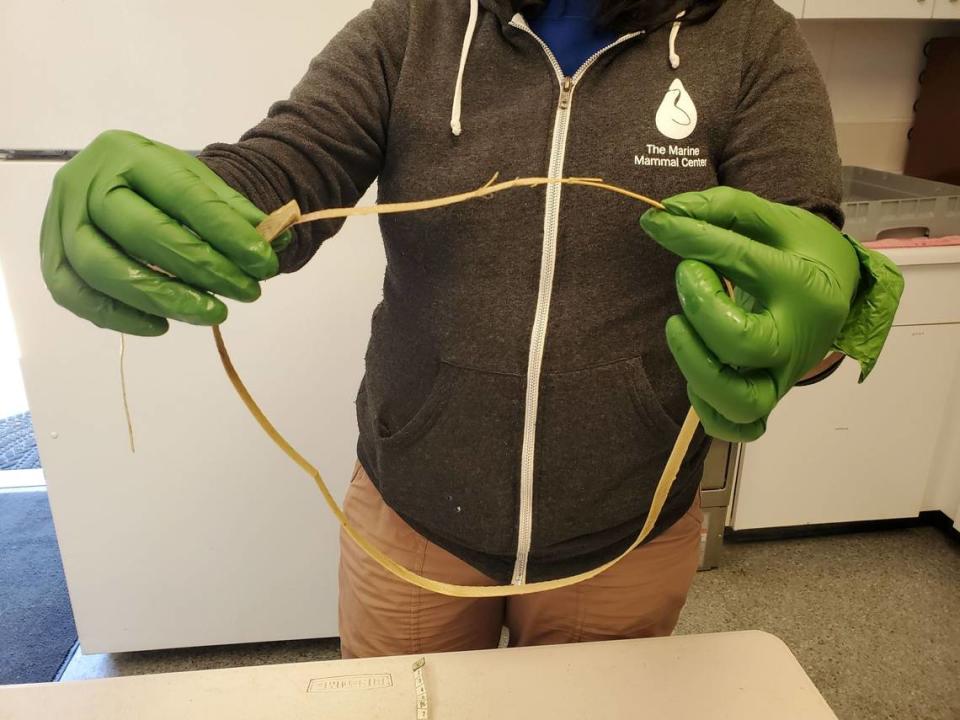How is SLO County elephant seal doing after rescue from plastic strap? ‘A happy girl’
Freed from the plastic packing strap that was slowly strangling her, the elephant seal known as “Necklace” rested peacefully on the beach at Piedras Blancas this week before apparently leaving for her annual migration.
While she was still there, wounds from the plastic strap that had been wrapped around her neck were visibly healing — though she’ll always have a scar.
“She showed her scar and waved her tags to the UCI school group this morning,” Friends of the Elephant Seal docent Phil Arnold posted to the docent’s group chat on Tuesday.
“I think she’s smiling!” another docent, Mary Forbes said.
Arnold agreed.
“I think Mary is right — she’s a happy girl,” he wrote.

In a joint effort from The Marine Mammal Center and Friends of the Elephant Seal, a piece of packing plastic that had become entangled around Necklace’s neck was removed last week.
The piece of plastic was hampering her ability to forage for food and slowly starving her until volunteers staged a rescue at Piedras Blancas to remove the item.
Though she has since appeared to have left the San Luis Obispo County beach, docents and visitors alike have been curious about what is up next for the now popular animal.
Will injured elephant seal have a pup?
Though she appears to have been healing happily, it is unclear whether Necklace was pregnant or could successfully carry a pup to term.
Pregnancy for seals starts after they finish nursing the previous pup. Necklace was on the beach in October with the juvenile seals, but she’s large enough to be considered an adult.
She wasn’t sighted at Piedras Blancas during the 2024 breeding season, but it is possible she may have had a pup on another beach. More than 97% of females over the age of four years get pregnant every year, so she may have gotten pregnant for the first time.
“If the seal will be at least four years old next winter, it is highly likely she is already pregnant,” Patrick Robinson, director of the Ano Nuevo Reserve, said in an email.
If she mated back in February or March, Necklace may have a fertilized egg that has been dormant since then.
Elephant seal pregnancies start that way, with a few cell divisions of the fertilized egg, becoming an embryo. Development then stops, with implantation of the embryo delayed several weeks, until after the seal molts.
Necklace, meanwhile, was observed with her molt completed this past week.

When the pregnant females return to the ocean after molting in May and June, they are on their long migration, until January. They spend that time feeding, supporting the developing embryo, and gaining blubber to sustain them through birth and nursing.
Necklace wasn’t sighted on the beach after Tuesday, so she may have already left on her long migration.
Females feed in the mesopelagic layer of the North Pacific, 660-3,300 feet deep. It’s a rich layer of fish, but the fish are only 3 inches long. To gain enough blubber on such small fish, females feed all day. They sleep less than four hours, and make as many as 60 dives to keep eating.
Necklace’s low weight may make her condition too poor to support an embryo. Her body is depleted, so even if she did have one, her body could resorb the embryo while she recovers her health and gains weight.

Want to spot Necklace on beach next year? Look for her unique scar
Many eyes will be looking for her in January, when the females return to have their pups. If she doesn’t have a pup this year, she’ll probably get pregnant then and have a pup the following year.
“We’re happy to see a seal get disentangled,” Robinson said. “We had a very similar seal up here that we disentangled last month. ”
Plastic pollution is a hazard for all marine species.
To help avoid other situations like Necklace’s, you can use less plastic, cut circular plastic rings before discarding and support organizations such as The Marine Mammal Center that are working to reduce plastic pollution.
Necklace will likely sport the scars from her run-in with a plastic strap for the rest of her life.
But those scars will help docents and visitors to identify her in the future.
In the meantime, Friends of the Elephant Seal offers programs to school field trips at all levels.
On Tuesday, Arnold spoke to Dr. Amy Henry and 19 graduate students from the University of California Irvine campus. They’d been “studying all things ocean” at Rancho Marino Reserve for several days. It’s become an annual field trip for the class.
“They are a great bunch of students, with lots of questions for Dave Lawrence and me,” Arnold said. “In the past we have gone tag hunting, but this year didn’t lend itself very well to that so we talked seals a lot. They are fun to work with.”
Friends of the Elephant Seal also has a Speakers’ Bureau that offers free presentations to service organizations, clubs, libraries and other groups.
Contact them at elephantseal.org/community-programs.

